反义疑问句讲解+习题
反义疑问句详解及练习和答案
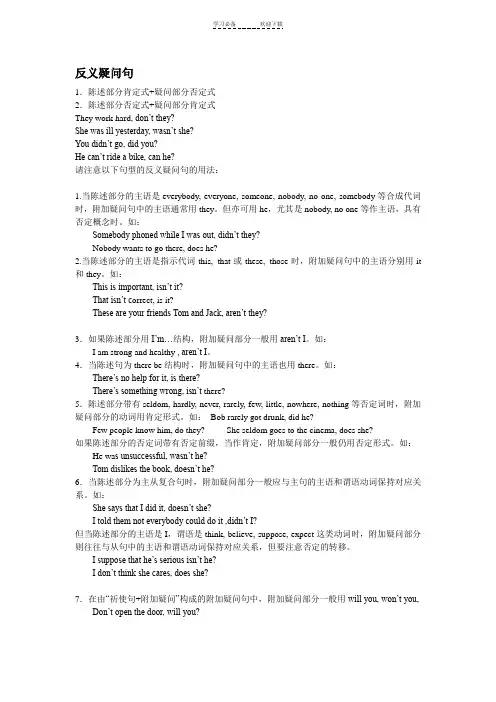
反义疑问句1.陈述部分肯定式+疑问部分否定式2.陈述部分否定式+疑问部分肯定式They work hard, don’t they?She was ill yesterday, wasn’t she?You didn’t go, did you?He can’t ride a bike, can he?请注意以下句型的反义疑问句的用法:1.当陈述部分的主语是everybody, everyone, someone, nobody, no one, somebody等合成代词时,附加疑问句中的主语通常用they。
但亦可用he,尤其是nobody, no one等作主语,具有否定概念时。
如:Somebody phoned while I was out, didn’t they?Nobody wants to go there, does he?2.当陈述部分的主语是指示代词this, that或these, those时,附加疑问句中的主语分别用it 和they。
如:This is important, isn’t it?That isn’t c orrect, is it?These are your friends Tom and Jack, aren’t they?3.如果陈述部分用I’m…结构,附加疑问部分一般用aren’t I。
如:I am strong and healthy , aren’t I。
4.当陈述句为there be结构时,附加疑问句中的主语也用there。
如:There’s no help for it, is there?There’s something wrong, isn’t there?5.陈述部分带有seldom, hardly, never, rarely, few, little, nowhere, nothing等否定词时,附加疑问部分的动词用肯定形式。
反义疑问句的讲解及练习(含答案)
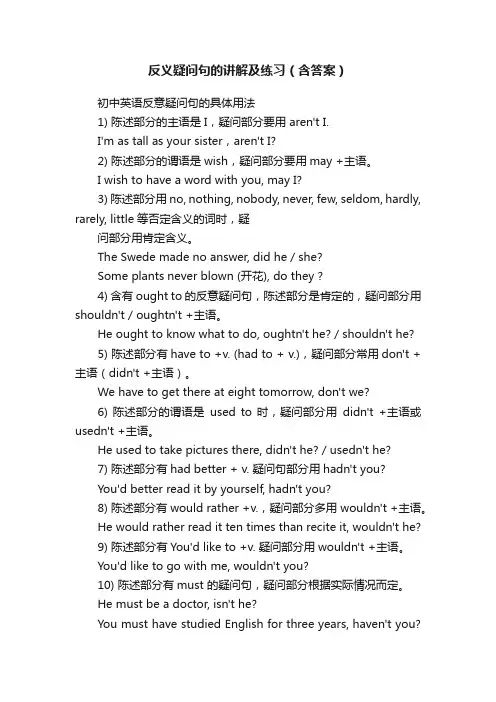
反义疑问句的讲解及练习(含答案)初中英语反意疑问句的具体用法1) 陈述部分的主语是I,疑问部分要用 aren't I.I'm as tall as your sister,aren't I?2) 陈述部分的谓语是wish,疑问部分要用may +主语。
I wish to have a word with you, may I?3) 陈述部分用 no, nothing, nobody, never, few, seldom, hardly, rarely, little等否定含义的词时,疑问部分用肯定含义。
The Swede made no answer, did he / she?Some plants never blown (开花), do they ?4) 含有ought to 的反意疑问句,陈述部分是肯定的,疑问部分用shouldn't / oughtn't +主语。
He ought to know what to do, oughtn't he? / shouldn't he?5) 陈述部分有have to +v. (had to + v.),疑问部分常用don't +主语(didn't +主语)。
We have to get there at eight tomorrow, don't we?6) 陈述部分的谓语是used to 时,疑问部分用didn't +主语或usedn't +主语。
He used to take pictures there, didn't he? / usedn't he?7) 陈述部分有had better + v. 疑问句部分用hadn't you?You'd better read it by yourself, hadn't you?8) 陈述部分有would rather +v.,疑问部分多用 wouldn't +主语。
反义疑问句讲解及习题及答案
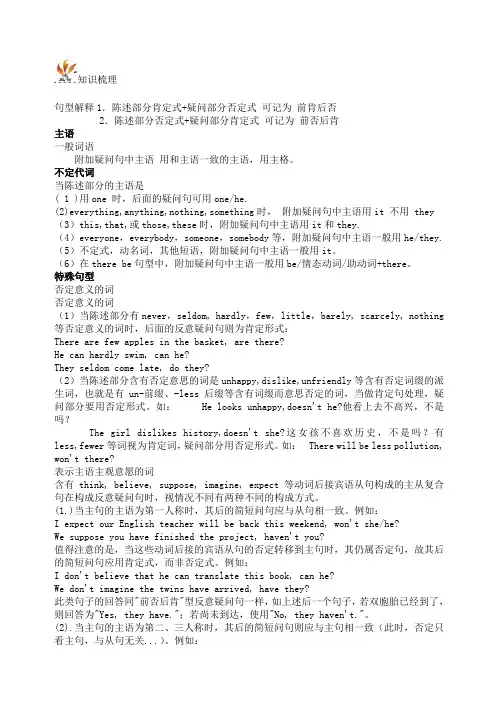
知识梳理句型解释1.陈述部分肯定式+疑问部分否定式可记为前肯后否2.陈述部分否定式+疑问部分肯定式可记为前否后肯主语一般词语附加疑问句中主语用和主语一致的主语,用主格。
不定代词当陈述部分的主语是( 1 )用one 时,后面的疑问句可用one/he.(2)everything,anything,nothing,something时,附加疑问句中主语用it 不用 they (3)this,that,或those,these时,附加疑问句中主语用it和they.(4)everyone,everybody,someone,somebody等,附加疑问句中主语一般用he/they. (5)不定式,动名词,其他短语,附加疑问句中主语一般用it。
(6)在there be句型中,附加疑问句中主语一般用be/情态动词/助动词+there。
特殊句型否定意义的词否定意义的词(1)当陈述部分有never,seldom, hardly,few,little,barely, scarcely, nothing 等否定意义的词时,后面的反意疑问句则为肯定形式:There are few apples in the basket, are there?He can hardly swim, can he?They seldom come late, do they?(2)当陈述部分含有否定意思的词是unhappy,dislike,unfriendly等含有否定词缀的派生词,也就是有un-前缀、-less后缀等含有词缀而意思否定的词,当做肯定句处理,疑问部分要用否定形式。
如:He looks unhappy,doesn't he?他看上去不高兴,不是吗?The girl dislikes history,doesn't she?这女孩不喜欢历史,不是吗?有less,fewer等词视为肯定词,疑问部分用否定形式。
如:There will be less pollution, won't there?表示主语主观意愿的词含有think, believe, suppose, imagine, expect等动词后接宾语从句构成的主从复合句在构成反意疑问句时,视情况不同有两种不同的构成方式。
反义疑问句讲解及习题
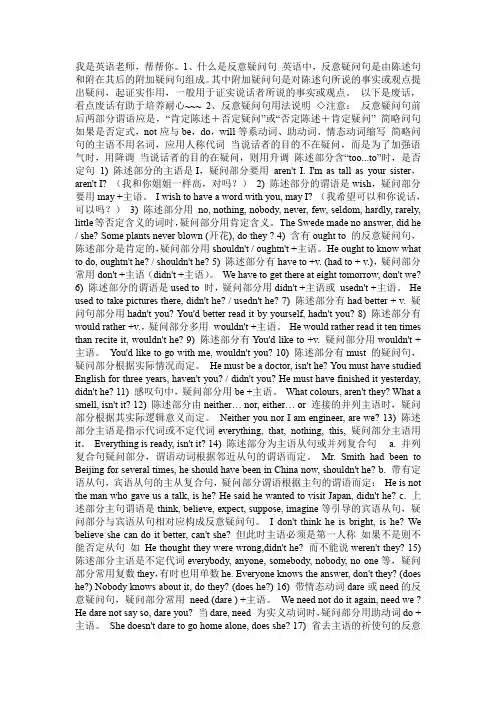
我是英语老师,帮帮你。
1、什么是反意疑问句英语中,反意疑问句是由陈述句和附在其后的附加疑问句组成。
其中附加疑问句是对陈述句所说的事实或观点提出疑问,起证实作用,一般用于证实说话者所说的事实或观点。
以下是废话,看点废话有助于培养耐心~~~ 2、反意疑问句用法说明◇注意:反意疑问句前后两部分谓语应是,“肯定陈述+否定疑问”或“否定陈述+肯定疑问” 简略问句如果是否定式,not应与be,do,will等系动词、助动词、情态动词缩写简略问句的主语不用名词,应用人称代词当说话者的目的不在疑问,而是为了加强语气时,用降调当说话者的目的在疑问,则用升调陈述部分含“too...to”时,是否定句1) 陈述部分的主语是I,疑问部分要用aren't I. I'm as tall as your sister,aren't I? (我和你姐姐一样高,对吗?)2) 陈述部分的谓语是wish,疑问部分要用may +主语。
I wish to have a word with you, may I? (我希望可以和你说话,可以吗?)3) 陈述部分用no, nothing, nobody, never, few, seldom, hardly, rarely, little等否定含义的词时,疑问部分用肯定含义。
The Swede made no answer, did he / she? Some plants never blown (开花), do they ? 4) 含有ought to 的反意疑问句,陈述部分是肯定的,疑问部分用shouldn't / oughtn't +主语。
He ought to know what to do, oughtn't he? / shouldn't he? 5) 陈述部分有have to +v. (had to + v.),疑问部分常用don't +主语(didn't +主语)。
反义疑问句练习题及答案解析
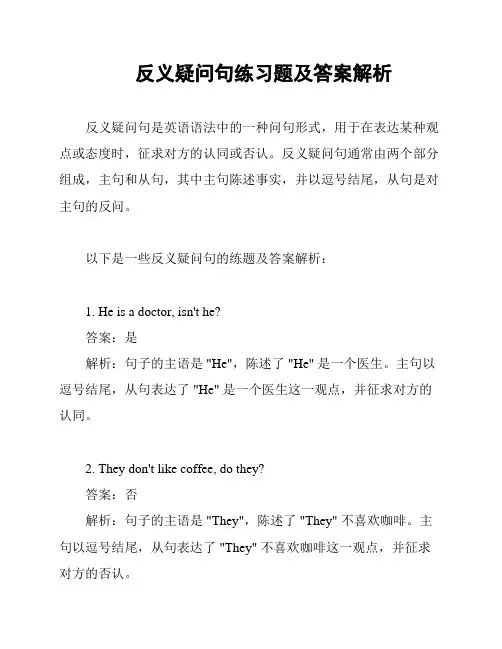
反义疑问句练习题及答案解析反义疑问句是英语语法中的一种问句形式,用于在表达某种观点或态度时,征求对方的认同或否认。
反义疑问句通常由两个部分组成,主句和从句,其中主句陈述事实,并以逗号结尾,从句是对主句的反问。
以下是一些反义疑问句的练题及答案解析:1. He is a doctor, isn't he?答案:是解析:句子的主语是 "He",陈述了 "He" 是一个医生。
主句以逗号结尾,从句表达了 "He" 是一个医生这一观点,并征求对方的认同。
2. They don't like coffee, do they?答案:否解析:句子的主语是 "They",陈述了 "They" 不喜欢咖啡。
主句以逗号结尾,从句表达了 "They" 不喜欢咖啡这一观点,并征求对方的否认。
3. You can swim, can't you?答案:是解析:句子的主语是 "You",陈述了 "You" 能游泳。
主句以逗号结尾,从句表达了 "You" 能游泳这一观点,并征求对方的认同。
4. She hasn't finished her homework, has she?答案:否解析:句子的主语是"She",陈述了"She" 没有完成她的作业。
主句以逗号结尾,从句表达了 "She" 没有完成她的作业这一观点,并征求对方的否认。
5. He won't be late, will he?答案:否解析:句子的主语是 "He",陈述了 "He" 不会迟到。
主句以逗号结尾,从句表达了"He" 不会迟到这一观点,并征求对方的否认。
反义疑问句讲解与练习
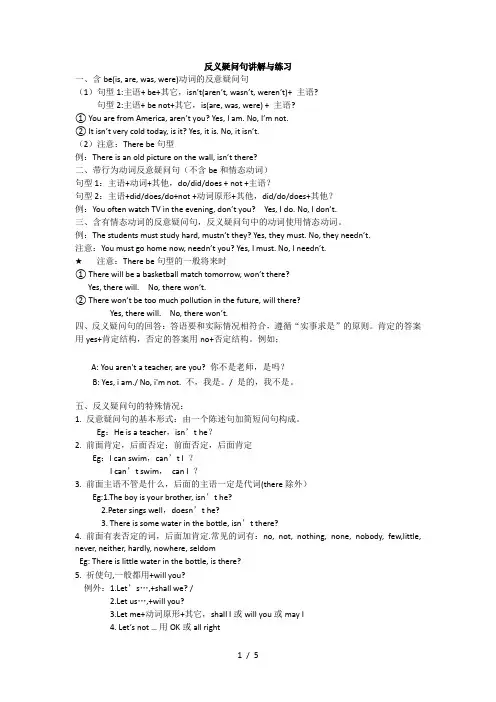
反义疑问句讲解与练习一、含be(is, are, was, were)动词的反意疑问句(1)句型1:主语+ be+其它,isn’t(aren’t, wasn’t, weren’t)+ 主语?句型2:主语+ be not+其它,is(are, was, were) + 主语?① You are from America, aren’t you? Yes, I am. No, I’m not.② It isn’t very cold today, is it? Yes, it is. No,it isn’t.(2)注意:There be句型例:There is an old picture on the wall, isn’t there?二、带行为动词反意疑问句(不含be和情态动词)句型1:主语+动词+其他,do/did/does + not +主语?句型2:主语+did/does/do+not +动词原形+其他,did/do/does+其他?例:You often watch TV in the evening, don’t you? Yes, I do. No, I don’t.三、含有情态动词的反意疑问句,反义疑问句中的动词使用情态动词。
例:The students must study hard, mustn’t they? Yes, they must. No, they needn’t.注意:You must go home now, needn’t you? Yes, I must. No, I needn’t.★注意:There be句型的一般将来时① There will be a basketball match tomorrow, won’t there?Yes, there will. No, there won’t.② There won’t be too much pollution in the future, will there?Yes, there will. No, there won’t.四、反义疑问句的回答:答语要和实际情况相符合,遵循“实事求是”的原则。
(完整)反义疑问句讲解和练习(答案)
反意疑问句一、英文中的反意疑问句。
1、什么是反意疑问句英语中,反意疑问句是由陈述句和附在其后的附加疑问句组成。
其中附加疑问句是对陈述句所说的事实或观点提出疑问,起证实作用,一般用于证实说话者所说的事实或观点.翻译为“是吗”2。
反意疑问句的回答,回答时,如果情况属实,用Yes加上反问句的倒装肯定句;若果情况不属实,则用No 加上反问句的倒装否定句。
例如You were moved by your students,weren’t you?情况属实:Yes, I were.情况不属实:No, I weren’t。
二、反意疑问句中问句部分的动词与陈述部分的动词在语气上成相反的对应关系,即:肯定+否定?否定+肯定?如:①You can't do it, can you?你不能做它,是吗?②They are very late for the meeting, aren’t they?他们开会迟到了,是吗?三.当陈述句中含有be动词,助动词,或是情态动词时,反问句部分由这些词加上主语人称代词构成。
She is a lovely girl,isn’t she?她是一个可爱的女孩,是吗?He will go home, __won’t__ __he__?他要回家了,是吗?She doesn’t l ike to eat popcorn, __does__ _she___?她不喜欢吃爆米花,是吗?The baby won't sleep early, will it?小宝宝睡得不早,是吗?注意:He has supper at home every day,doesn’t’t he? (不能用hasn’t he?)他每天在家吃晚饭,是吗?They have known the matter,haven’t they? (不能用don’t they?)他们已经知道那事情了,是吗?小试牛刀:It’s very hot today, _______________ ?He can speak Chinese, _______________ ?It _______________ a good day for swimming, is it?Tom has been to Singapore , _______________ ?She do esn’t like climbing hills , _______________ ?四.当陈述句中只含有行为动词时,若动词加了s,就用does, 若动词为原形,就用do,动词为过去式,则用did,例如:You cleaned your house last week, _didn’t___ __you__?你上周打扫了你的房间,是吗?Your father plays the computer very well, __doesn’t__ ___he _?你父亲电脑技术很好,是吗?They look so happy today, _don’t ___ _they___?你今天看起来很高兴,是吗?小试牛刀: Meimei studies in a middle school, _______________ ?He loves cold weather , _______________ ?You finished the task yesterday, _______________ ?五.反意疑问句的陈述部分带有little, few, never, hardly, seldom,nobody, nothing,barely, scarcely等否定意义的词时,问句部分用肯定式.如:①She never tells a lie, does she?(不用doesn’t she?)她从不说谎,是吗?②He was seldom late, was he?(不用wasn’t he?) 他几乎不迟到,是吗?小试牛刀:Few students can answer the question, _______________ ?He can hardly finish his homework, _______________ ?六、反意疑问句的陈述部分为I am……时,问句部分习惯上用aren’t I?表示.如:I am a very honest man, aren’t I? 我是个很诚实的人,是吗?小试牛刀:I’m in Class 3,Grade 2, _______________ ?I’m ten years old, _______________ ?七.陈述部分的主语为不定代词something, anything, nothing, everything时,问句部分的主语用it。
(完整版)反义疑问句详细讲解及习题及答案
反义疑问句一.句型解释反义疑问句(The Disjunctive Question):即附加疑问句。
它表示提问人的看法,没有把握,需要对方证实。
反义疑问句由两部分组成:前一部分是一个陈述句,后一部分是一个简短的疑问句,两部分的人称时态应保持一致。
1.陈述部分肯定式+疑问部分否定式2.陈述部分否定式+疑问部分肯定式She was ill yesterday, wasn’t she?You didn’t go, did you?二.特殊的句型1.祈使句。
祈使句后一般加上will you或won't you构成反意疑问句,用will you 多表示“请求”,用won't you 多表示提醒对方注意。
例如:Let引导的祈使句有两种情况:1) Let's...,后的反意疑问句用shall we或shan't we。
例如:Let's go home, shall we/ shan't we? 回家吧,好吗?2)Let us/me...后的反意疑问句用will you或won't you。
例如:Let me have a try, will you/won't you?3)祈使句都用will you 或won’t you2.当陈述部分含I think (believe, suppose...)that... 结构时,其反意疑问句须与从句的主、谓语保持一致,注意主句的主语必须是第一人称。
例如:I don't think he will come, will he?若是非第一人称,则与主句的主语相一致He thinks that she will come, doesn’t he?反意疑问句的陈述部分为I(We) don’t think(believe, suppose, consider)+ that从句时,从句为否定意义,问句部分的动词和主语仍与that从句保持一致且用肯定式。
中考英语反义疑问句讲解及习题!
中考英语反义疑问句讲解及习题!如:①Do sit down, won’t you?/ will you?②You feed the bird today, will you?③Please open the window, will you? (won’t you?)(十七)、陈述部分为否定祈使句时,问句部分一般用will you?形式。
如: Don’t make any noise, will you?(十八)、陈述部分为There (Here) + be + 主语时,问句部分用动词+there (here)?形式。
①There are two cakes on the plate, aren’t there?②Here is a story about Mark Twain, isn’t here?(十九)、陈述部分用had better +原形动词表示建议时,问句部分用hadn’t +主语?形式。
①You’d better tell him about the matter, hadn’t you?②We had better do it by ourselves, hadn’t we?(二十)、陈述部分用used to +主语时,问句部分用didn’t + 主语?或usedn’t +主语?形式。
①He used to live in the country, didn’t he?/usedn’t he?②They used to be good friends, didn’t they?/usedn’t they?(二十一)、陈述部分用must (may, might) + have + V-ed表示推测时,若句中带有明显的过去时间的状语,问句部分动词用过去时形式。
如:①He might have forgotten his pen in the classroom yesterday, didn’t he?②You must have got up late this morning, didn’t you? (二十二)、陈述部分用must (may, might) + have + V-ed表示推测时,若句中没有带明显的过去时间的状语,问句部分动词用现在完成时形式。
初中语法-反义疑问句解析及练习
• —Yes, she has. 不,来过。 • —No, she hasn’t是的,没来过
• 1. ——You won't follow his example, will you?
there? 4.Nothing is in the room, _i_s_ it?
5.The boys and girls have never been to Chongqing, _h_a_v_e__ they?
三. 反意疑问句的陈述部分为 I am… 时, 问句部分习惯上 用 aren’t I?表 示。
• ( )2. His sister have a bad cough, ___B_____ she?
• (A) wasn't (B) doesn't (C) hadn't (D) didn't
• ( )3. John can hardly understand any Chinese, __C_____ he?
to Canada, __A_____?
(A) will she
(B) won't she
(C) isn't she
(D) wasn't she
1. Tom helped me a lot last year, ___d_id_n_’t_ ______h_e_ ?
2.They haven’t been to the Great Wall, __h_a_ve__ __t_h_e_y__ ?
② Nothing has happened to them, has it?
- 1、下载文档前请自行甄别文档内容的完整性,平台不提供额外的编辑、内容补充、找答案等附加服务。
- 2、"仅部分预览"的文档,不可在线预览部分如存在完整性等问题,可反馈申请退款(可完整预览的文档不适用该条件!)。
- 3、如文档侵犯您的权益,请联系客服反馈,我们会尽快为您处理(人工客服工作时间:9:00-18:30)。
反义疑问句讲解及练习由"陈述句 + 附加疑问句"两部分构成。
一般有两种形式:前肯后否或前否后肯。
对附加疑问部分应注意以下几点: 1)主语只能用人称代词;2)附加疑问句的not必须与(be /助/情)缩写;3)附加疑问句的时态必须与陈述部分的时态一致。
eg.1)Tom is a work, isn't Tom?(找错)_______2)You can swim, can not you?(找错)______3)He had lunch, doesn't he?(找错)________特别注意以下几种反意疑问句1.陈述部分含否定意味的词(few, little, never, nothing, nobody, no, hardly, none),附加疑问句应使用肯定形式(但前缀词unhappy, unlike, disappear等列外)eg. They are unhappy, aren't they?2.特别注意以下几种反意疑问句1. 陈述部分含否定意味的词(few, little, never, nothing, nobody, no, hardly, none),附加疑问句应使用肯定形式(但前缀词unhappy, unlike, disappear等列外) eg. They are unhappy, aren't they?eg.1)Everything is ready, ___________?2)Everyone is here, ____________?3.陈述部分是祈使句时,附加疑问句一般用:will you? 但注意:Let's … , shall we?Let us … , will you?4.陈述部分含must时,附加疑问句一般用needn't.eg. I must finish my work now, _________?5.陈述部分是there be结构时,应用there be结构来完成。
eg. There's little water, ___________6.陈述部分含宾语从句时,疑问部分通常与主句一致。
但当主句的谓语动词是think, believe且主语是I , we时,即:I / We think (believe) + 宾从,则附加问句应与从句一致。
I'm sure + 宾从也是如此eg.1)She said I did it, ____________?2)We don't think you are right, ________?3)I'm sure you'll help me, ____________?7.I'm… , aren't I?eg.I am older than you, __________?8.陈述部分含had better, 疑问部分应用had better来回答。
eg. You'd better go out , ___________?9.陈述部分是感叹句,附加问句的人称代词应与主语一致。
eg. 1)What a kind girl, __________? 2)What a fine day, ___________?练习1.You had to work for 10 hours yesterday, _____?A. didn't youB. did not youC. had not youD. did you2.Don't eat too much, ____?A. will youB. don't youC. do youD. can you3.Lily looks like Lucy, ____?A. is LilyB. isn't sheC. does LilyD. doesn't she4.-You didn't change your mind, did you --- ______.A. No, I didn'tB. Yes, did IC. No, I didD. Yes, I didn't5.The woman hardly let her daughter go to school, ____ she ?A. doesB. doesn'tC. didD. didn't6.Be sure to come to the parents' meeting on time, ____?A. will youB. aren't youC. can't youD. mustn't you7.Let's have a good rest, ____?A. will weB. do weC. shalln't weD. shall we8.He has never ridden a horse before, ___?A. does heB. has heC. hasn't heD. doesn't9.Tom has supper at school, ___?A. hasn't heB. has heC. doesn't heD. does he10.There is little water in the glass, ___?A. isn't thereB. isn't itC. is itD. is there十六、简单句的五种句型1.主语 + 不及物动词(主、谓结构)eg. He is working.2.主语+ 及物动词 + 宾语(主、谓、宾结构)eg. We study English every day.3.主语+ 连系动词 + 表语(主、系、表结构)eg. Trees turn green.常见的连系动词有:be become get turn feel look(看起来);smell(闻起来); sound(听起来);taste(尝起来);seem(似乎).特别注意:形容词常作表语4.主语 + 及物动词 + 间宾(人)+ 直宾(物)=主语+ 及物动词 + 直宾(物)+ to / for + 间宾(人)常用的此类动词有:give pass show lend buy. 但buy与for连用eg. 1)I gave him a book. = I gave a book to him.2)My mother bought me a pen yesterday. = My mother bought a pen for me.5.主语 + 及物动词 + 宾语 + 宾补注意作宾补的词:1)名词(指宾语是谁/什么);2)形容词;3)不定式;4)动词的ing 形式。
eg.1)We call him Jim.2) We must keep the window open.3)He told me to wash the plates.4)I saw a thief going into your room.特别注意:1)动词不定式作宾补A: ask / want / tell sb to do sth.其否定式为:ask/want/tell sb not to do sth2)省to不定式作宾补,即:(l, m, n; 3h; 2看; 1f) sb do sthl-let, m-make, n-notice; 3h-hear, have , help; 2-see, watch; 1f-feel.eg. 1)The boss made the workers work 12 hours every day.2)I often hear him sing.3)区别省to不定式作宾补与动词ing形式作宾补.hear / see sb do: 听见/看见某人做了某事hear / see sb doing: 听见/看见某人在做某事否定意义的词否定意义的词(1)当陈述部分有never,seldom, hardly,few,little,barely, scarcely, nothing,none,rarely 等否定意义的词汇时,后面的反意疑问句则为肯定形式: There are few apples in the basket, are there? He can hardly swim, can he? They seldom come late, do they?(2)当陈述部分含有否定意思的词是unhappy,dislike,unfriendly等含有否定词缀的派生词,也就是有un-前缀、-less后缀等含有词缀而意思否定的词,当做肯定句处理,疑问部分要用否定形式。
如: He looks unhappy,doesn't he?他看上去不高兴,不是吗? The girl dislikes history,doesn't she?这女孩不喜欢历史,不是吗?有less,fewer等词视为肯定词,疑问部分用否定形式。
如: There will be less pollution, won't there? 表示主语主观意愿的词含有think, believe, suppose, imagine, expect等动词后接宾语从句构成的主从复合句在构成反意疑问句时,视情况不同有两种不同的构成方式。
(1.)当主句的主语为第一人称时,其后的简短问句应与从句相一致。
例: I expect our English teacher will be back this weekend, won't she/he? We suppose you ha ve finished the project, haven't you?值得注意的是,当这些动词后接的宾语从句的否定转移到主句时,其仍属否定句,故其后的简短问句应用肯定式,而非否定式。
例: I don't believe that he can translate this book, can he? We don't imagine the twins have a rrived, have they? 此类句子的回答同"前否后肯"型反意疑问句一样,如上述后一个句子,若双胞胎已经到了,则回答为"Yes, they have.";若尚未到达,使用"No, they haven't."。
